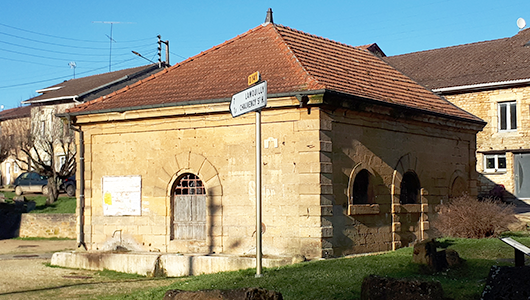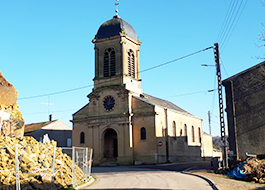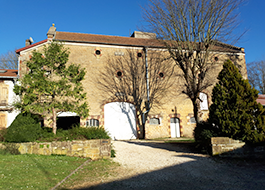Chauvency-le-Château
Durée visite : 20 minutes
Moyen : Pédestre
Propriété des comtes de Chiny, qui l’érigent en commune affranchie en 1240, Chauvency est célèbre pour son tournoi de 1285. Organisé sur cinq jours par Gérard de Loos, héritier des Chiny, il réunit des participants, membres des familles aristocratiques de la région. Des chevaliers viennent aussi de beaucoup plus loin.
En 1436, un chevalier plus brigand que jouteur, Robert de Sarrebrück, s’empare du château. Surnommé par anti-phrase le Damoiseau, il ravage le pays et les bourses de contribuables. Il est chassé par le duc de Bourgogne, le bien nommé Philippe le Bon.
Prévôté française en 1661, le village voit sa forteresse démantelée. Pendant la Révolution, elle perd son surnom de château pour le plus correct alors de La Montagne. Au XIXe, les habitants, qui travaillent pour certains à la scierie, peuvent se désaltérer grâce à la brasserie et la distillerie, également présentes dans le bourg.
Owned by the counts of Chiny, who set it up as a freed commune in 1240, Chauvency is famous for its tournament of 1285. Organized over five days by Gérard de Loos, heir to the Chinys, it brings together participants, members of aristocratic families in the region. . Knights also come from much further away.
In 1436, a knight more brigand than jouster, Robert de Sarrebrück, seized the castle. Nicknamed by anti-phrase the Damoiseau, he ravages the country and the stock exchanges of taxpayers. He is hunted by the Duke of Burgundy, the aptly named Philippe le Bon.
French provost in 1661, the village saw its fortress dismantled. During the Revolution, it loses its nickname of castle for the more correct then of La Montagne. In the 19th century, the inhabitants, some of whom worked at the sawmill, were able to quench their thirst at the brewery and the distillery, also present in the town.
Chauvency gehört den Grafen von Chiny, der es 1240 als befreite Gemeinde errichtete. Es ist berühmt für sein Turnier von 1285. Es wird von Gérard de Loos, dem Erben der Chinys, an fünf Tagen organisiert und bringt Teilnehmer, Mitglieder aristokratischer Familien in der Region, zusammen. . Ritter kommen auch von viel weiter weg.
1436 eroberte ein Ritter, der mehr Räuber als Jouster war, Robert de Sarrebrück, die Burg. Mit dem Spitznamen Damoiseau verwüstet er das Land und die Börsen der Steuerzahler. Er wird vom Herzog von Burgund, dem treffend benannten Philippe le Bon, gejagt.
Der französische Provost im Jahr 1661 sah das Dorf seine Festung abgebaut. Während der Revolution verliert es seinen Spitznamen Schloss für das korrektere als La Montagne. Im 19. Jahrhundert konnten die Einwohner, von denen einige im Sägewerk arbeiteten, ihren Durst in der ebenfalls in der Stadt vorhandenen Brauerei und Brennerei stillen.
Les points de visites
.
Ce lavoir à impluvium date du XIXe siècle. Il est couvert sur ses quatre côtés d’une toiture à longs pans. Les lavandières y accèdent par deux portes à linteaux droits. Contre le mur se trouve un abreuvoir avec sa borne fontaine à couronnement. Un linteau sur une porte à droite est daté de 1765.
Le nom d’Enfer de cette rue n’est peut-être pas fortuit. Il s’agissait d’effrayer les enfants pour éviter qu’ils n’approchent du lavoir et s’y noient.
This wash house with impluvium dates from the 19th century. It is covered on its four sides with a roof with long sides. The washerwomen access it by two doors with straight lintels. Against the wall is a drinking trough with its crowned fountain. A lintel on a door to the right is dated 1765.
The name Hell of this street is perhaps not accidental. This was to scare the children to prevent them from approaching the washhouse and drowning there.
Dieses Waschhaus mit Impluvium stammt aus dem 19. Jahrhundert. Es ist an seinen vier Seiten mit einem Dach mit langen Seiten bedeckt. Die Wäscherinnen erreichen es durch zwei Türen mit geraden Stürzen. An der Wand steht ein Trinktrog mit seinem gekrönten Brunnen. Ein Sturz an einer Tür rechts ist mit 1765 datiert. Der Name Hölle dieser Straße ist vielleicht kein Zufall. Dies sollte die Kinder erschrecken, um sie daran zu hindern, sich dem Waschhaus zu nähern und dort zu ertrinken.
.
.
L’église saint-Amand date de 1858. Au-dessus de la porte, le registre supérieur est couvert d’une archivolte cintrée. Deux niches vides de statues y sont abritées. La rosace centrale, sur fond de vitrail, possède un cadran d’horloge réalisé par Guioth de Stenay. Une toiture à l’impériale, semblable à celle de saint-Denis de Juvigny-sur-Loison, couronne l’ensemble. L’originalité de cette tour-clocher tient aux quatre colonnes d’angles, décorées de chapiteaux ioniques.
Saint-Amand de Maastricht vécut au VIIe siècle. Il est considéré comme le fondateur de l’Eglise de Belgique. Bien que reposant à saint-Amand des Eaux, il est le patron des brasseurs et des marchands de vin. On le fête, avec modération, le 6 février. Son attribut est un serpent, qu’il aurait fait fuir d’un signe de croix.
The Saint-Amand church dates from 1858. Above the door, the upper register is covered with an arched archivolt. Two empty niches of statues are housed there. The central rose window, against a stained glass background, has a clock face made by Guioth de Stenay. An imperial roof, similar to that of Saint-Denis de Juvigny-sur-Loison, crowns the whole. The originality of this bell tower lies in the four corner columns, decorated with Ionic capitals.
Saint-Amand of Maastricht lived in the 7th century. He is considered to be the founder of the Church of Belgium. Although resting in Saint-Amand des Eaux, he is the patron saint of brewers and wine merchants. It is celebrated, in moderation, on February 6. His attribute is a snake, which he would have made flee with a sign of the cross.
Die Saint-Amand-Kirche stammt aus dem Jahr 1858. Über der Tür befindet sich das obere Register mit einem gewölbten Archivolten. Dort sind zwei leere Nischen mit Statuen untergebracht. Das zentrale Rosettenfenster vor einem Buntglashintergrund hat ein Zifferblatt von Guioth de Stenay. Ein kaiserliches Dach, ähnlich dem von Saint-Denis de Juvigny-sur-Loison, krönt das Ganze. Die Originalität dieses Glockenturms liegt in den vier Ecksäulen, die mit ionischen Kapitellen verziert sind.
Saint-Amand von Maastricht lebte im 7. Jahrhundert. Er gilt als Gründer der belgischen Kirche. Obwohl er in Saint-Amand des Eaux ruht, ist er der Schutzpatron der Brauer und Weinhändler. Es wird in Maßen am 6. Februar gefeiert. Sein Attribut ist eine Schlange, die er mit einem Kreuzzeichen hätte fliehen lassen.
.
Située 40, rue Nationale, l’ancienne distillerie Claisse a été en activité entre 1890 et 1910. Ce bâtiment produisit un alcool de seigle connu sous le nom de grain de Chauvency.
Located at 40, rue Nationale, the former Claisse distillery was in operation between 1890 and 1910. This building produced a rye alcohol known as grain de Chauvency.
Die ehemalige Claisse-Brennerei in der Rue Nationale 40 war zwischen 1890 und 1910 in Betrieb. In diesem Gebäude wurde ein Roggenalkohol hergestellt, der als Grain de Chauvency bekannt ist.








